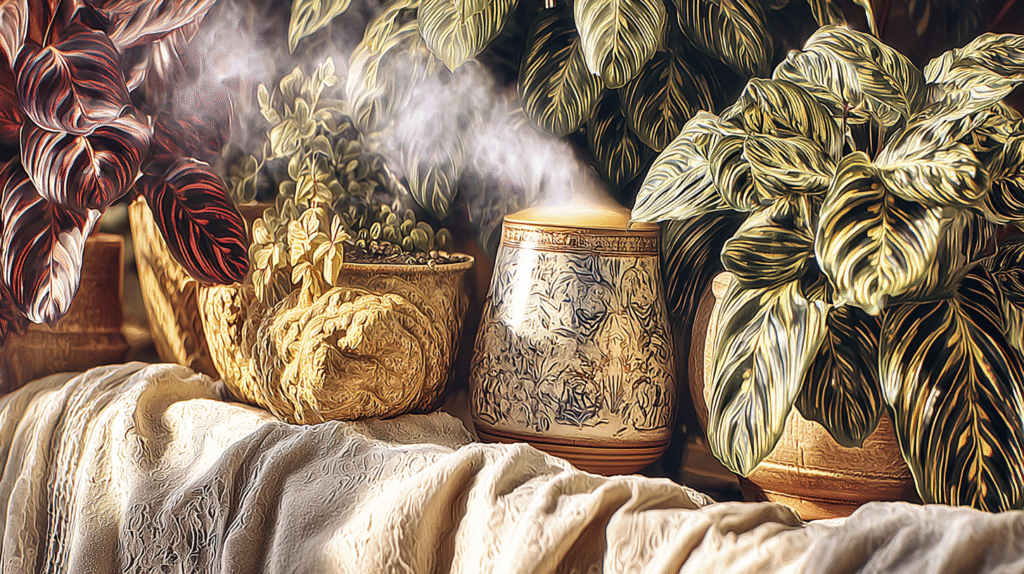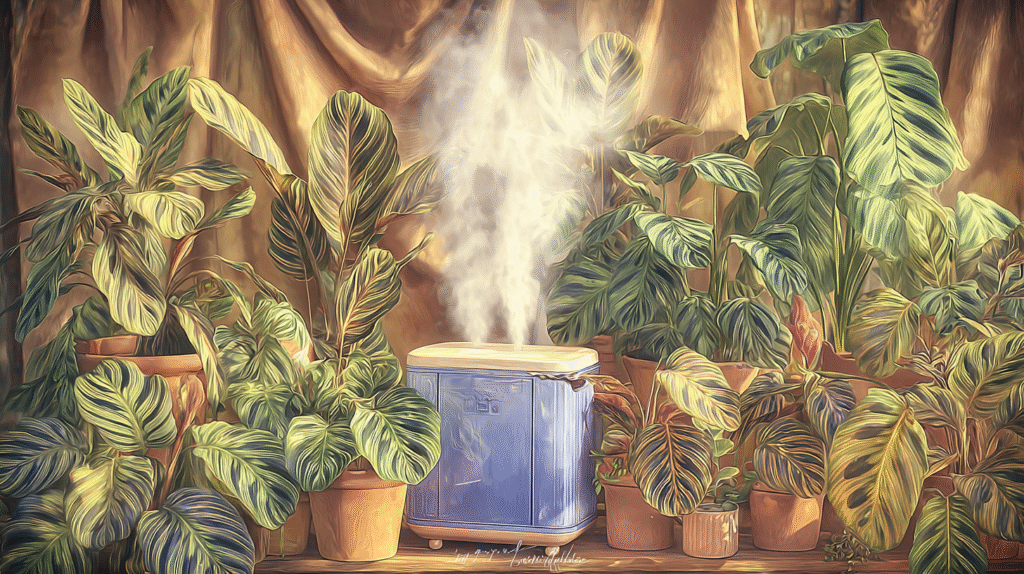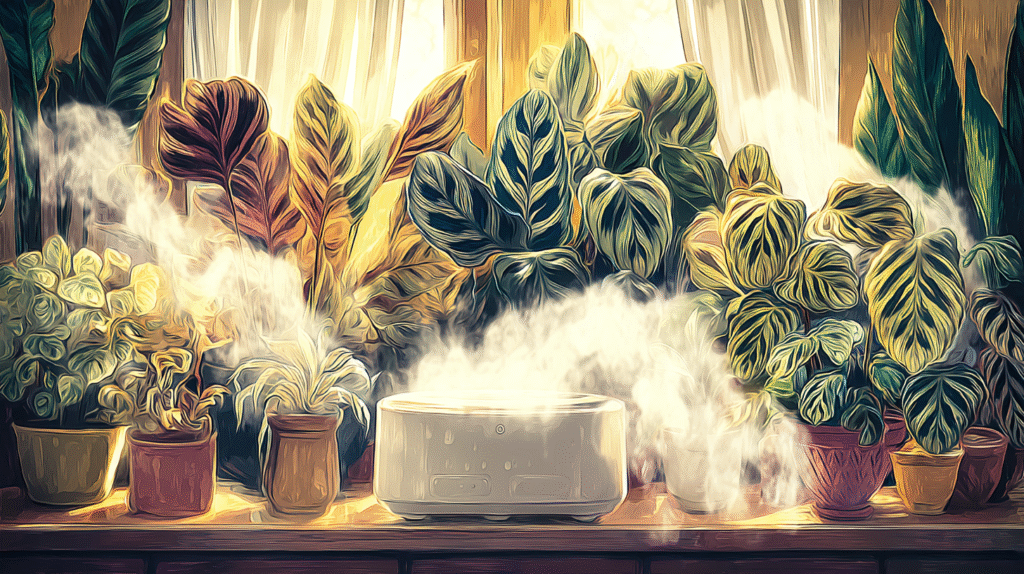I should’ve known what I was getting into when the plant shop employee said, “Calatheas are a bit… particular.” That was like saying the ocean is a bit wet. My first calathea — a stunning rattlesnake plant — went from Instagram-worthy to crispy-edged nightmare in two weeks flat.
That was the beginning of what I now call my “calathea education.” Over three years, I’ve owned twelve different varieties. Currently, five are thriving, two are on life support, and five are composted memories. But those five thriving ones? They’re so gorgeous that I keep coming back for more punishment.
If you’re considering a calathea or currently watching yours throw a dramatic death scene, here’s everything I’ve learned about keeping these divas happy.
Why Calatheas Are Like That
Before diving into care, understand what you’re dealing with. Calatheas come from rainforest floors where they get:
- Filtered light through tree canopy
- Constant humidity (70%+)
- Consistent temperatures
- Rain water (no chemicals)
- Perfect air circulation
Your home offers:
- Dry air
- Tap water full of chemicals
- Temperature fluctuations
- Probably too much or too little light
No wonder they’re cranky.
The Humidity Battle: My Biggest Lesson
This is where most calathea relationships fail. They want rainforest humidity while living in your desert-dry apartment.
What didn’t work:
- Misting (caused fungal spots)
- Pebble trays (barely made a dent)
- Grouping plants (helped 5%)
- Bathroom without humidifier (still too dry)
What actually worked: Buying a humidifier. Full stop. My humidity went from 30% to 55%, and my calatheas went from dying to thriving. The $40 humidifier saved my $150 plant collection.
The placement trick: I created a “humidity zone” — humidifier in the center, calatheas arranged around it. They’re basically having a constant spa day.

Water: The Second Biggest Drama
Calatheas are the goldilocks of water. Too much? Root rot. Too little? Crispy edges. Wrong type? Brown tips forever.
The water journey:
- Tap water: Brown edges on everything
- Filtered water: Better but still some browning
- Distilled water: Good but expensive
- Rain water: Perfect but inconvenient
- Filtered water left out 24 hours: My sweet spot
My watering routine:
- Check soil moisture every 2-3 days
- Water when top inch is dry but deeper soil is slightly moist
- Never let them fully dry out
- Never let them sit in water
- Always room temperature water
That rattlesnake plant that almost died? Started thriving once I stopped using straight tap water.
Light: Not What You Think
Everyone says “low light,” which killed my first two calatheas. They don’t want low light — they want bright, indirect light.
Where mine failed:
- Dark corner (“they like shade!”): Stopped growing, lost color
- Direct sun: Bleached and burned within days
- Too far from windows: Slowly declined
Where mine thrived:
- 3-4 feet from east window
- North window with good ambient light
- Near (not in) west window with sheers
- Under grow lights set to 50% intensity
My medallion calathea sits 4 feet from an east window and looks like it was painted by an artist. Same plant in a dark corner looked like sadness incarnate.
The Prayer Plant Movement That Freaked Me Out
Nobody warned me that calatheas move. The first night I heard rustling and thought I had mice. Nope — just my calatheas doing their nightly prayer plant routine, folding up their leaves.
This movement tells you a lot:
- Healthy plants move dramatically
- Weak plants barely move
- No movement = probably dying
- Extra dramatic movement = very happy
My healthiest ornata sounds like paper crinkling every evening. It’s creepy but reassuring.
Varieties: My Successes and Failures
The Survivors:
Rattlesnake (Calathea lancifolia):
- Most forgiving calathea
- Handles lower humidity better
- My gateway drug to calatheas
Network (Calathea musaica):
- Surprisingly tough
- Less crispy than others
- Gorgeous patterns
Medallion (Calathea medallion):
- Stunning but needs high humidity
- Worth the effort
- Mine is 2 feet wide now
The Failures:
White Fusion:
- Paid $60, dead in 3 months
- Needs 70%+ humidity
- Not apartment-friendly
Calathea orbifolia:
- Beautiful large leaves
- Crisped despite all efforts
- Maybe someday I’ll try again
Common Problems I’ve Battled
Brown edges (The universal calathea issue):
- Usually water quality or low humidity
- Sometimes overfertilizing
- Won’t go away but new growth can be clean
Curling leaves:
- Too dry (air or soil)
- Too much light
- Sometimes temperature stress
Spider mites:
- Love calatheas
- Check undersides weekly
- Shower prevention works
Yellow leaves:
- Usually overwatering
- Sometimes natural aging
- Check roots if widespread

The Soil Secret That Changed Everything
Calatheas need moisture but hate wet feet. Tricky balance. My mix:
- 50% peat-based potting mix
- 25% perlite
- 25% orchid bark
- Handful of charcoal
This holds moisture while staying airy. My root rot incidents dropped to zero after switching.
Fertilizing: Less Than You Think
First year: Fertilized weekly, burned everything Second year: Monthly at half-strength, better Now: Every 6 weeks in growing season, quarter strength
Calatheas are light feeders. That white fusion might’ve lived if I hadn’t been so fertilizer-happy.
The Turning Point
After a year of failures, I almost gave up. Then I visited a friend whose calatheas looked like magazine photos. Her secret? She’d created a microclimate:
- Humidifier running constantly
- All calatheas grouped together
- Near a window but not in direct light
- Only distilled water
- Minimal fussing
I copied her setup. Within a month, my surviving calatheas perked up. New growth appeared without crispy edges. The prayer plant movement got more dramatic.
Why I Keep Buying Them
You’d think after composting $200 worth of failed calatheas, I’d stick to pothos. But when your medallion unfurls a perfect new leaf, when your rattlesnake’s patterns catch the light, when your pin-stripe’s pink lines glow in morning sun — you understand.
They’re not easy. They’re not forgiving. But they’re absolutely stunning when happy. My thriving calatheas are conversation starters, mood lifters, and proof that I can keep difficult plants alive (sometimes).
Real Talk for Calathea Beginners
Start with one rattlesnake plant. If you can keep it happy for six months, consider expanding. If it’s struggling:
- Check humidity first (probably too low)
- Check water quality (probably too hard)
- Check light (probably not enough)
- Accept some leaf imperfections
Perfect calathea leaves only exist in greenhouses. Home-grown ones will have some crispy bits. It’s character.

The Bottom Line
Calatheas aren’t starter plants. They’re for people who like challenges, have humidifiers, and don’t mind filtered water routines. They’re for obsessive plant parents who check humidity levels and inspect leaves daily.
But if you nail their care? You’ll have living art that moves, changes, and never gets boring. My five thriving calatheas bring more joy than any easy plant ever has. They’ve taught me patience, humility, and the importance of a good humidifier.
Just maybe start with one before buying five different varieties like I did. Your wallet and sanity will thank you. But who am I kidding — once you see that perfect medallion pattern, you’ll want them all too. 🌿






